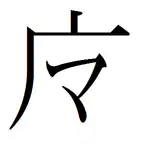摩
| ||||||||
| ||||||||
Translingual
Han character
摩 (Kangxi radical 64, 手+11, 15 strokes, cangjie input 戈金手 (ICQ) or 戈木手 (IDQ), four-corner 00252, composition ⿸麻手)
References
- KangXi: page 450, character 28
- Dai Kanwa Jiten: character 12613
- Dae Jaweon: page 801, character 10
- Hanyu Da Zidian (first edition): volume 3, page 1940, character 7
- Unihan data for U+6469
- Unihan data for U+2F8C3
Chinese
| trad. | 摩 | |
|---|---|---|
| simp. # | 摩 | |
| alternative forms | 擵 攠 | |
Glyph origin
Characters in the same phonetic series (麻) (Zhengzhang, 2003)
Phono-semantic compound (形聲, OC *maːl, *maːls) : phonetic 麻 (OC *mraːl) + semantic 手 (“hand”).
Pronunciation
Definitions
摩
Compounds
Derived terms from 摩
|
|
Descendants
Japanese
| Shinjitai | 摩 | |
| Kyūjitai [1] |
摩󠄁 摩+ 󠄁?(Adobe-Japan1) |
 |
| 摩󠄃 摩+ 󠄃?(Hanyo-Denshi) (Moji_Joho) | ||
| The displayed kanji may be different from the image due to your environment. See here for details. | ||

Ryakuji for 摩, a phono-semantic simplification as 广 (radical/semantic) + マ (phonetic “ma” for on reading), also used for 魔; compare 機 and 議.
Readings
Compounds
- 研摩 (kenma)
- 摩滅 (mametsu)
Korean
Etymology
From Middle Chinese 摩 (MC muɑ, muɑH).
Vietnamese
This article is issued from Wiktionary. The text is licensed under Creative Commons - Attribution - Sharealike. Additional terms may apply for the media files.